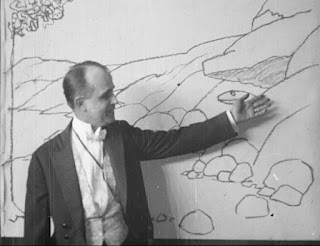On March 1, the Chicago Film Seminar hosted a discussion with the co-winners of the Society for Cinema and Media Studies Best First Book Award for 2016–2017, Miriam J. Petty (Northwestern University) and Allison McCracken (DePaul University), moderated by Allyson Nadia Field (University of Chicago).
To start things off, Petty gave an overview of her book, Stealing the Show: African American Performers and Audiences in 1930s Hollywood. Through five case studies—of Louise Beavers, Fredi Washington, Hattie McDaniel, Lincoln “Stepin Fetchit” Perry, and Bill “Bojangles” Robinson—the book explores the possibilities and limitations of African American stardom in 1930s Hollywood. Before going on to talk in more detail about Robinson as an exemplar of the work of the book, Petty went into some of the broader context and background for the book. She explained how the title Stealing the Show represents the bifurcated response to African American performers at the time. “Stealing the show” was a term used in the 1930s by both African American press and mainstream press to refer to African American performers; when it appeared in the latter, it was patronizing, limited and limiting praise, relegating performers to the margins of Hollywood movies, whereas in the African American press, the term is critical of Hollywood’s limited opportunities for African Americans, and is used to praise the performer while simultaneously criticizing the role in which they appear—in other words, a way to credit African American actors for doing much with little. Working with a definition of stardom from Richard Dyer, of the star as a structured polysemy, a multi-faceted gem, Petty asked how this notion of stardom could be available to or possible for African American performers in 1930s Hollywood. How can performers relegated to roles on the margins (maid, butler, mammies, porters) be stars? How can polysemic significance be seen in roles that are seemingly extremely limited? Petty found answers to these questions by studying reception, specifically the ways that African American audiences engaged with performers such as Bill “Bojangles” Robinson. For instance, Petty recognized that children and childhood are a central part of Robinson’s stardom in ways that go beyond his association with Shirley Temple. Elements of his stardom—including play, mentorship, and philanthropy—come to the fore with African American children in particular, both on a textual level and a spectatorial level. Petty showed a clip from the 1935 film Hooray for Love in order to demonstrate some of these elements of Robinson’s stardom, and how that stardom becomes more nuanced when we take into account African American spectatorship.
Allison McCracken provided a brief response to Petty, in which she outlined interests that both books share (cultural shifts in the 1930s that went unstudied for a long time, reception studies over media text or industry, and particularly how subaltern audiences can have an impact on culture), before introducing her own book, Real Men Don’t Sing: Crooning in American Culture. McCracken identified her book as a story of the rise and fall of romantic crooners, beginning in the 1880s and with a focus on the 1920s and 1930s, and provided a brief timeline of crooning in American culture, ending with the crooning “culture wars” in the 1930s. According to McCracken, the popularity of crooning in the 1920s prompted a massive backlash, wherein new masculinity codes needed to be constructed for white male popular singers and their voices. This led to the stigmatization and cultural devaluation of crooning, or the establishment of what McCracken calls the “crooner paradigm,” a cultural construction from the early 1930s that still applies today in the way young male pop stars are talked about in the press and in popular discourse. The crooner paradigm includes characteristics such as effeminacy and femininity, suspect sexuality, artless commercial production, and exclusively female/feminine fans portrayed as mindless hysterics and emotionally excessive. McCracken went on to trace the history of the term “crooning” in American culture. A Scottish term that was originally associated in nineteenth-century America with mammies and “crooning mammy” songs in minstrelsy, “crooning” was later applied more broadly to the intimate singing between mother and child before becoming fully deracinated and broadened, finally associated in the early twentieth century with romantic courtship. In the 1920s, the modern crooner was created with technological advancements that finally allow for soft, intimate crooning to be recorded and broadcast, thus changing singing forever, as projection from the chest was no longer necessary. McCracken then turned to a discussion of Rudy Vallée, the first romantic crooner and U.S. pop idol, and played a clip of his song “Deep Night” (1929) in order to demonstrate the melodic, soft, emotional quality of his voice. She also showed photos to show the submissive and feminine/gender transgressive qualities of his persona. Attacks on crooners, led by Cardinal O’Connor of Boston in 1932–33, opened the floodgates to condemnation of crooning. Bing Crosby for one was able to survive the backlash by recuperating his playboy persona, and as an example of this McCracken showed a clip from Rhythm on the Range (1936), where Crosby sings to a bull instead of the woman in the scene, before ending with a scene from The Big Broadcast of 1932, in which Crosby is chased by female fans, thus demonstrating the enduring cultural anxiety about women’s romantic tastes, sexual agency, and buying power.
Petty then gave a brief response to McCracken, in which she identified the ways in which both books are interested in a traffic in affect, where producing affective responses allows an opportunity for stars to speak to marginalized audiences. She also related the policing of Vallée’s and Crosby’s masculinity to more contemporary instances of the policing of masculinity, such as with Luther Vandross or Boyz II Men. Finally, she drew a connection between the two books through the way that each deals with how technology creates a kind of identity that can’t be controlled by the performer themselves.
Allyson Field then moderated a discussion with both presenters. Beginning with the observation that both books originated as dissertations, she asked Petty and McCracken what had changed in terms of archives and access between dissertation and book. McCracken said that the biggest change was the digitization of Variety, which has benefits and drawbacks, and Petty also experienced using different research methods, such as searching keywords in digitized books, when adding new sections for the book version of her dissertation. Both authors agreed that another huge change was the new availability of films, especially on formats like YouTube. Field then suggested that both books would not be possible without the sort of hybrid methodology that comes from straddling the transition to digitization, and emphasized how both kinds of approaches are valuable.
The evening ended with a question that referred back to the idea of contemporary crooners and the body, particularly in 1980s African American music, and how this might relate to an embodied sense of masculinity/femininity in Vallée’s look. McCracken responded that the natural wave in Vallée’s hair indicated his Irishness but also seemed to align with the artificially wavy hair favored by homosexuals of the time.
Announcements:
The University of Chicago’s annual graduate student conference will be held April 20–21, 2018. The topic of this year’s conference is “Sensing Media,” featuring a keynote address by Mark B.N. Hansen. More information can be found at https://sensingmedia.wordpress.com.
The Great Lakes Association for Sound Studies (GLASS) is holding a conference April 20–21, 2018 at the University of Wisconsin-Madison. For more information, see their Facebook page at https://www.facebook.com/GreatLakesAssociationforSoundStudies.
Attendees of the event included:
Ben Aspray
Nicholas Baer
Crystal Camargo
Kelly Coyne
Michael DeAngelis
Ilana Emmett
Samantha Freeman
Jirard
Barbara Klinger
Sergio Mims
Ariel Rogers
Molly Schneider
Jordan Schonig
Nova Smith
Annie Sullivan
Shannon Tarbell
Ashley Truehart








